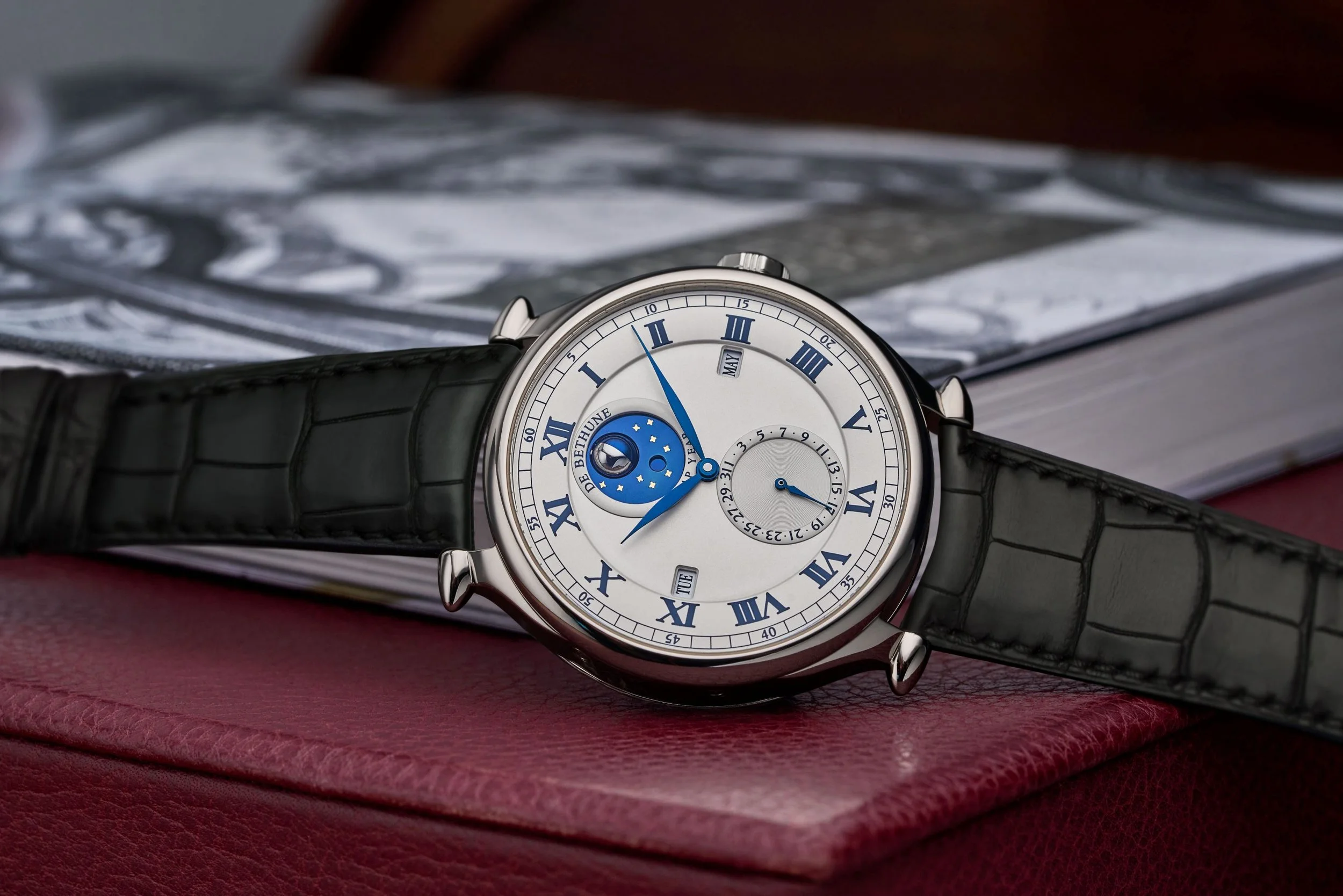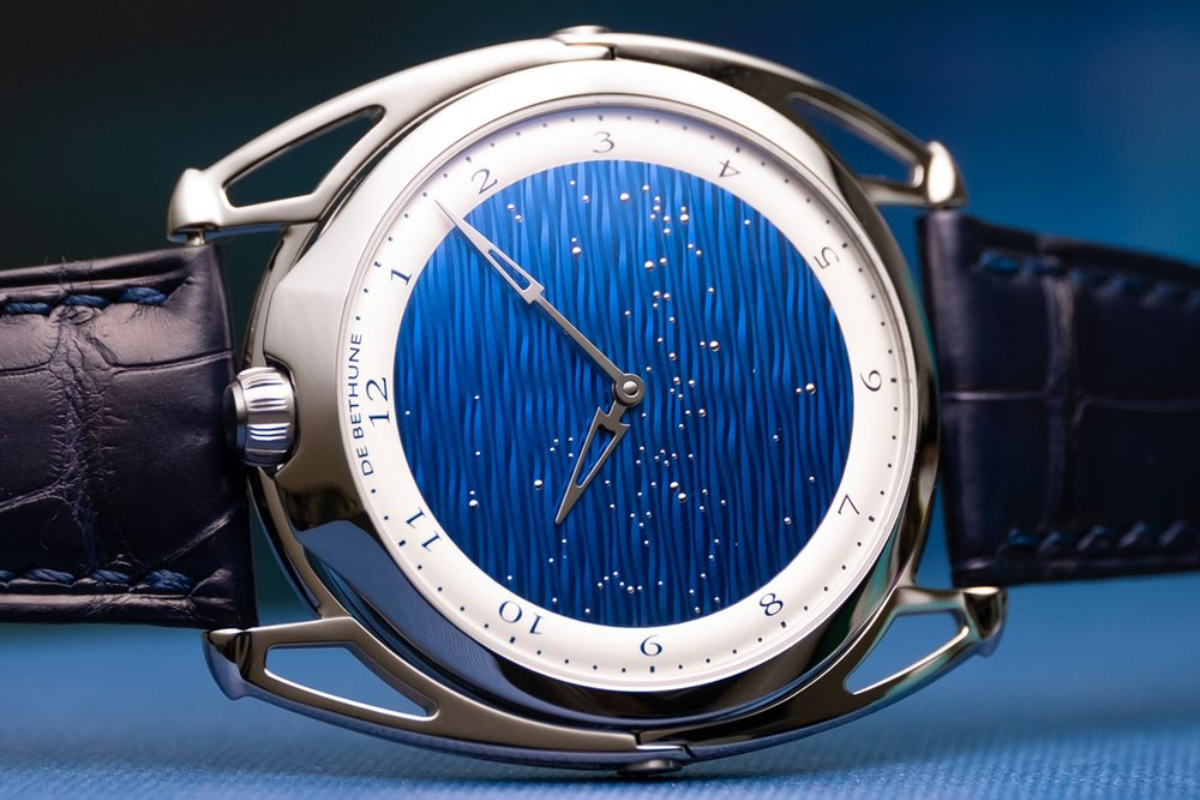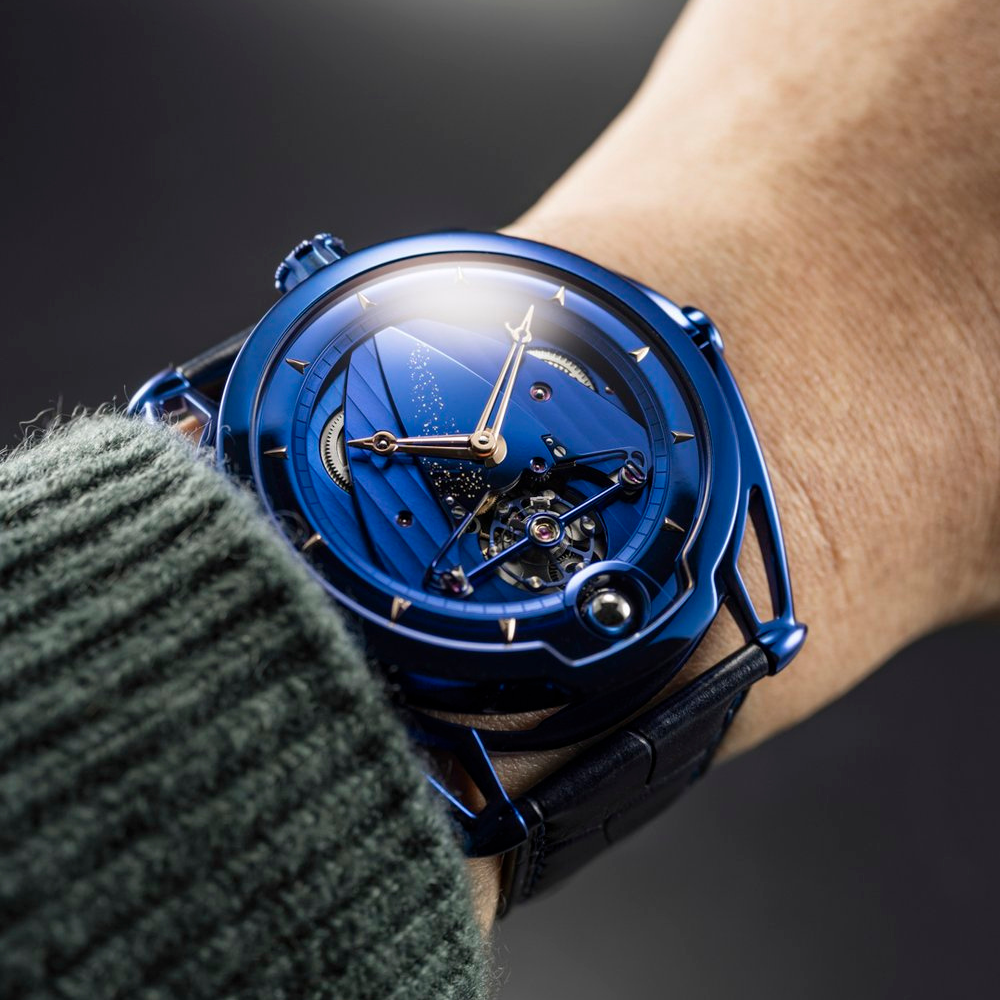Inspired by the Heavens – A Look at de Bethune’s Celestial Dials
Since its launch in 2002, De Bethune has always been drawn to the stars. The DB3, released the same year as the brand’s founding, featured a moonphase complication. In 2004, the DB15 added more of the heavens with a blued moonphase subdial and surrounding star decoration. Things have progressed a lot since then. What went from a small portion of the dial – the moonphase with its stars – has become an entire design language.
The beginnings of the stars decorated on the dial of De Bethune watches, the DB15
Today, we’re digging into the history of De Bethune’s affinity with the heavenly bodies, especially as found on their timepieces’ dials. From where it starts to how it evolves, we’re moving through the brand’s catalog with some added context taken from Horological Alchemy, the book written by Denis Flageollet, De Bethune’s co-founder and master watchmaker.
De Bethune’s blue, celestial dials – a brief history
For anyone with familiarity with De Bethune, there are probably a few images that spring to mind when we think of their timepieces. One is extensive bluing – blued dials, blued movement components, and even entirely blued watches (the DB28 Kind of Blue). Another image that comes to mind is the brand’s dials, often blued with gold stars strewn across. There are a variety of different models that feature this design – many include “Starry” in the the timepiece’s name.
Bluing to its limit, the DB28 Kind of Blue
In recent years, there has been a wave of spectacular, “starry” dialed timepieces from De Bethune. Some of these include the DB25 Starry Varius Aérolite (2022), a timepiece we covered for its genuinely spectacular caliber, the DB28XP Meteorite (2021), the DB28XP Starry Sky (2020), the DB25 Starry Varius (2020), DB25 Starry Varius Chronomètre Tourbillon (2019), and the list goes on.
The attention-grabbing celestial dial of the DB25 Starry Varius Rose Gold
While the blued, starry sky motif has taken off in recent years, its origins date back to the very first few years of De Bethune. Found initially on a DBL – released in 2005 and only 5 pieces in circulation – this is the first time we observe a star-speckled, blued dial. It wasn’t until 2010 with the DB25 Moon Phase Starry Sky (the first “Starry Sky” model) that this aesthetic returned to the dial of a De Bethune timepiece.
The first fully blued, starry sky motif timepiece – the ultra-limited DBL from 2005
If you take a broad look at the brand’s catalog (something highly recommended with De Bethune: The Art of Watchmaking), this period from the early to mid 2010s is significant for De Bethune. In this period, both these renown celestial dials as well as the pursuit of bluing excellence becomes more pronounced. After an initial 5-year hiatus from the “starry sky” dial, it appears on a new timepiece every year from 2010 onward. As far as the gradual accumulation of experience, perfecting bluing, it’s in this period that the DB28 Kind of Blue appears (2016). It’s really a representation of the trend toward the visually-stunning deep blue, cosmic color brought to its farthest extreme – everything blued from case to dial to movement.
An up-close look at the gold gilding on the DB25 Starry Varius Rose Gold
Advancing to the extreme of tradition
In its origin, the process of heat-treating any metal serves a practical purpose in watchmaking: it prevents rusting. On the most granular level, applying a flame to metal causes a reaction, the metal loses one or more of its electrons and in doing so, creates a thin film of iron (ferrous) oxide. The thickness of the iron oxide film determines how light diffracts from the metal, leaving a color to the metal that can range from straw yellow to brown to violet to De Bethune’s signature intense blue. Combined with gold gilding or the application of gold pegs inserted into the dial, the brand’s starry dials are a novel coming-together of historically well-established watchmaking methods.
One of the brand’s most recent, updated extra-thin timepieces – the DB28XP Starry Sky
Enthralled by the beauty of these timepieces, it’s easy to miss that this “De Bethune” aesthetic is the byproduct of Denis Flageollet’s novel approach to watchmaking.
On one hand, Flageollet is a major figure driving modern independent watchmaking, creating timepieces that look and feel thoroughly 21st century. You will simply not find a timepiece that closely resembles the iconic DB28 with its articulated lugs and movement construction in 18th or 19th century watchmaking. On the other hand though, Flageollet is extremely specific and traditional with his approach to crafting these modern, horological marvels. We see the commitment to highest levels of traditional watchmaking with the DB Kind of Grande Complication – all of Flageollet’s complication development experience over 20+ years in one timepiece.
Highly complicated, the DB Kind of Grande Complication with its celestial dial
Writing Horological Alchemy, Flageollet’s book on his own approach to watchmaking, we can see how his commitment to bluing and traditional aesthetic motifs (the stars) in watchmaking juxtapose with broader trends in watchmaking.
“Over the last two decades, the watchmaking industry has developed a habit, often out of marketing considerations rather than technical ones, of blending all sorts of exotic materials and alloys, generally from – or purporting to be from – aviation, aerospace, Formula 1 racing or even the medical domain, under the pretense of ‘advanced research’ and especially ‘innovation.’ While some of these alloys demonstrate product-enhancing properties, such as greater hardness, lightness or anti-magnetism, many of them have no discernible effect on functionality or aesthetics.” – pg. 78, Horological Alchemy
Our view is, there’s a “big picture” way to understand the eye-catching, beautiful application of bluing and gold gilding, culminating in the De Bethune’s celestial dials or in recent years, its use of meteorite in timepieces like the DB28xs Aérolite. This is all Denis Flageollet pulling the tradition to its extreme.
Blued meteorite with guilloche and gold gilding, the DB28xs Aérolite is a marvel
The historical practicality of bluing coupled with the broad, cultural affinity with the heavenly bodies in watchmaking, De Bethune took “small” decorative motifs in tradition, often found only on specific components or segmented areas of the dial, and blew them up to become defining features of the watch (and brand) as a whole. That’s where the novelty of De Bethune’s blued celestial dials really is. It’s not that they are simply beautiful – they are – but that it takes the entirety of center stage. It’s not simply a motif. It’s a core part of De Bethune’s watchmaking identity.









